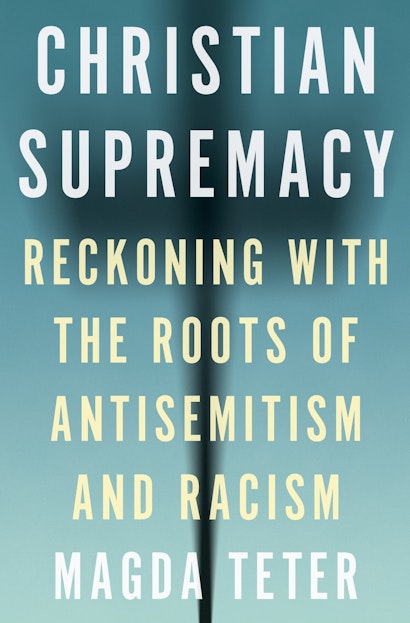Soon after his indictment by the Manhattan District Attorney was announced, Donald Trump issued a statement in which he proclaimed the following: “Manhattan DA Alvin Bragg, who was handpicked and funded by George Soros, is a disgrace.”[1] The next day, protesters gathered in front of the DA’s office, one holding a sign: “Google It! George Soros Funds D.A. Alvin Bragg.”[2] With these attacks, Trump and his supporters, including Trump-supporting media outlets, tapped into deep-rooted antisemitic and racist ideas of Jewish power and Black gullibility, thus connecting antisemitism and racism.
But this is not an accidental link. These two tropes, which had developed separately, have been used together for over a century both in the United States and in Europe. In 1889, Senator John Tyler Morgan of Alabama, a staunch opponent of the Reconstruction amendments, published an essay titled “Shall Negro Majorities Rule?”[3] In that essay, Morgan lambasted political rights for Black Americans and sought to justify their gradual disenfranchisement “by whatever means,” even if “unlawfully.”[4] Morgan opposed any “elevation” of Black people and combatted laws that, in his eyes, “demand[ed] the humiliation of the white race, or the admission of the Negroes to a dangerous participation, as a race, in the affairs of our government.”[5] The Alabama senator deemed Black people as “dependent and inferior.” For Morgan, the “Negro question” was both “a race question” and a political question related to the “political power accorded to the African race.” As voters, enfranchised Blacks were “without merit or capacity” but now “indued with power to influence the destiny of the whole country through their votes.” For all the doom about “Negro power,” Morgan asserted Black inferiority by claiming that Black Americans needed white or mixed-race allies, who in turn would join in “for the purposes of plunder.”[6] (Cartoons in US magazines showed Jews exploiting the supposedly dull-witted Black people.)
In the twentieth century, Jews would come to be seen as such supposed allies of Black Americans, exploiting them to subvert the white Christian society.[7] This idea was promoted on both sides of the Atlantic, by the Nazis in Europe and, especially after World War II, by American white supremacists such as George Lincoln Rockwell, who blamed Jews for encouraging “race mixing” and supporting Black civil rights to undermine white hegemony. (Jews were thought to be manipulating Chief Justice Earl Warren.) This returned more recently in an ad run by the RNC in 2018 in MN-01, featuring George Soros and Colin Kaepernick as “agents of chaos.” And now, in the Trump supporters’ backlash against Alvin Bragg.
Both the antisemitic idea of Jewish power and the racist idea of Black gullibility question the legitimacy of the social and political position of Jews and Black people, and, ultimately, signal their rejection as equals. Both, perhaps surprisingly, are rooted in conceptions of slavery and servitude, and thus social inferiority. Slavery and servitude, though a legal non-racialized reality in antiquity, came to be attached to Jews by Christians as a metaphorical idiom to describe Christianity’s relation to Judaism with Jews doomed to “perpetual servitude.” This theological idea was then translated into law, creating among Christians habits of thinking about Jews as perpetually inferior.[8] In this rendering, centuries before slavery and servitude came to be associated with Blackness, freedom became linked to Christianity and servitude to Judaism.
The concept of Jewish servitude and hierarchy emerges from Paul’s epistles, in which he allegorically casts followers of Jesus as the children of the promise (just as Isaac was the son of the promise born to Sarah, a free woman) and Jews who rejected Jesus and his message as children of the flesh (like Ishmael, born to Hagar, a slave woman, through sexual conception). It was not, Paul wrote, the children of the flesh who are the children of God but the children of the promise who are counted as descendants, part of God’s plan.[9] Jacob and Esau illustrated God’s will and the idea of predestination: “Even before they had been born or had done anything good or bad (so that God’s purpose of election might continue, not by works but by his call) she was told, ‘The elder shall serve the younger.’ As it is written, ‘I have loved Jacob, but I have hated Esau’” [Rom 9:10-13]. The gospels provided the idea that Jews were dangerous enemies of Christ.
Centuries later, Paul’s words would be translated into Christian law, degrading Jews’ social status. Thus, Christians developed a sense of superiority over Jews, now seen as carnal, inferior, and rejected by God. During the Middle Ages, this power dynamic was depicted in the allegorical personification of Ecclesia as a ruling queen, representing the Church and Christianity, and Synagoga as a blindfolded and humiliated maid, representing Jews and Judaism.
By the time European Christian powers began to expand their reach to the coast of Africa and into the Western hemisphere, their sense of superiority was firmly rooted. With European colonial expansion, white Christian supremacy and identity were born. Ecclesia was now replaced by the figure of Europa, a Christian queen dominating other continents—Africa, America, and Asia, which, in turn, took place of the Synagoga. But it was the legally sanctioned enslavement of Black Africans in the European colonies that created a more defined mental and legal hierarchy delineated along color lines. Freedom and liberty now came to be linked not only to Christianity but also to whiteness, and servitude and enslavement to Blackness.[10] A racial hierarchy was established.
The enslavement of Black Africans thus reinforced the self-perception of European superiority. Enlightenment thinkers, living and writing at the height of the transatlantic slave trade—even those most revered in Western intellectual history, such as Voltaire, David Hume, and Emanuel Kant—embraced the idea of the racial inferiority of non-Europeans, especially Africans (Voltaire even espoused polygenism) and used it to justify their enslavement. At the same time, European Jews, even those who had lived in Europe for over a millennium, were de-Europeanized and called “orientals” or “Asiatics.” When the French Revolution arrived with its slogans of “Liberty, Equality, and Fraternity,” Jews in Europe and Black people in European colonies tested the sincerity of these ideals.
Although both Jews and Black people were eventually—if reluctantly—admitted to the ranks of citizens in the Western world, their status and social position were continuously questioned, and their social advancement were deemed by white Christians, both in Europe and across the Atlantic, as illegitimate. Jews’ social climb gave rise to the pernicious antisemitic trope of “Jewish power”: Jews’ prominent position was seen as “usurped” to the detriment of the Christian population. Equality and success contradicted the theologically rooted trope of Jewish inferiority and the idiom of servitude. In the case of Black people, the legacy of enslavement still marks their lived experiences—even those most educated and accomplished continue to be seen through, as George Yancy put it, the prism of “the historical power of the white gaze,” which, among other things, denies them intellectual, professional, or political accomplishments.[11]
The reaction of Trump and his supporters to District Attorney Bragg’s indictment then demonstrates both the elision in white society of intellectual accomplishments of Black people and the myth of Jewish power. Both are rooted in the trope of slavery and servitude—historically, an idiom for Jews and the de jure reality for Black people. This interlocking antisemitic and racist legacy at play today undermines Jewish and Black Americans’ status as citizens and questions their legitimacy in public office.
Magda Teter is professor of history and the Shvidler Chair in Judaic Studies at Fordham University. She is the author of Blood Libel: On the Trail of an Antisemitic Myth, which won a National Jewish Book Award; Sinners on Trial: Jews and Sacrilege after the Reformation; and Jews and Heretics in Catholic Poland.
Notes
[1] https://twitter.com/TeamTrump/status/1641567635245789186, linked in https://www.washingtonpost.com/politics/2023/04/01/incendiary-claim-that-george-soros-funds-alvin-bragg/
[2] https://www.washingtonpost.com/politics/2023/04/01/incendiary-claim-that-george-soros-funds-alvin-bragg/
[3] John Tyler Morgan, “Shall Negro Majorities Rule?,” The Forum February (1889): 586-599.
[4] Morgan, “Shall Negro Majorities Rule?,” 593.
[5] Morgan, “Shall Negro Majorities Rule?,” 587, 591.
[6] Morgan, “Shall Negro Majorities Rule?,” 595-596.
[7] E.g. George Lincoln Rockwell, White Power (Dallas: Ragnarok Press, 1967).
[8] Recently, M. Lindsey Kaplan has explored this theme in the medieval context, in her excellent study, M. Lindsay Kaplan, Figuring Racism in Medieval Christianity (New York, Oxford: Oxford University Press, 2019).
[9] Romans 9:6-8.
[10] Barbara J. Fields, “Slavery, Race, and Ideology in the United States of America,” New Left Review 181, no. May-June (1990): 114; Tyler Edward Stovall, White Freedom: The Racial History of an Idea (Princeton: Princeton University Press, 2021).
[11] Yancy, Black Bodies, White Gaze, xix and 22. See, also, for example, Barack Obama, “Remarks by the President on Trayvon Martin,” in Office of the Press Secretary, ed. The White House (July 19th, 2013). Taylor Lewis, “6 Times President Obama Honestly Shared His Own Experiences with Racism,” Essence, October 27, 2020. Abby Goodnough, “Harvard Professor Jailed; Officer Is Accused of Bias,” The New York Times, 2009/07/21/ 2009. Also, Jones, White Too Long.

